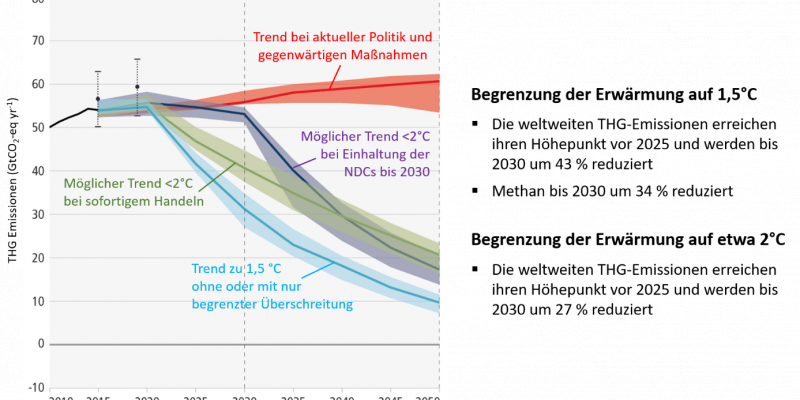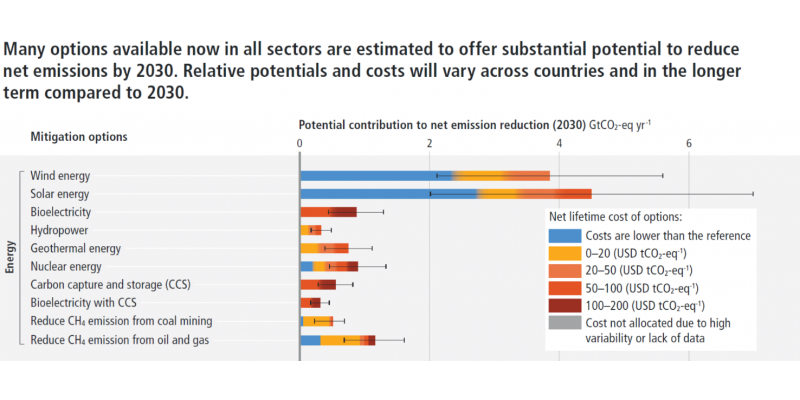Mitigating Climate Change – What is Necessary and Possible
translated from german: https://www.umweltbundesamt.de/minderung-des-klimawandels-was-notwendig-moeglich#fazit-zu-teil-iii-des-6-ipcc-berichts


The third part of the 6th IPCC assessment report assessed the progress in limiting global greenhouse gas emissions and the range of reduction and action options in all sectors. Without rapid political implementation, the global temperature target of 1.5°C by 2100 is no longer achievable. Ambitious climate protection is also the prerequisite for successful climate adaptation.
At the beginning of April, the third part of the 6th Assessment Report (AR 6) of the United Nations Intergovernmental Panel on Climate Change (u2060IPCCu2060) was published. Around 18,000 scientific studies were evaluated to update the AR 5 from 2013/14. A key finding of the IPCC report is that it is currently still possible to limit global warming to 1.5°C in the long term. However, the CO2 budget that we still have left for this can hardly be met given current international climate policy.
An important lever for climate protection is sustainable development: the richest 10% of private households account for up to 45% of greenhouse gas emissions worldwide. At the same time, the report shows that demand-side mitigation approaches, nature conservation and sustainable system transformations enable immense emissions reductions. We have to decide whether we trust in uncertain future technologies or implement ambitious and sustainable climate protection with the means available
Central message of the IPCC report
Probably the most important message of the IPCC report is that it is still technically and economically possible to limit global warming to 1.5°C by 2100 in accordance with the Paris Climate Agreement (see Fig. 1). However, this requires an immediate global turnaround as well as profound greenhouse gas (GHG) reductions in all regions of the world and all sectors – i.e. in energy systems, in cities, in agriculture and forestry, in land use, in buildings, in transport and in industry –. Particularly cost-effective and sustainable technologies are available in the energy sector, especially solar and wind energy (see Fig. 2). Immediate climate action compatible with the Paris Agreement would also only slightly reduce global GDP growth. The potential damage caused by “climate change” is not taken into account, nor are the adaptation costs avoided.
The third part of the 6th IPCC assessment report entitled “Mitigation of Climate Change” offers an internationally coordinated and objective basis for science-based political decisions in climate protection. The report also analyzes the different options in the context of sustainable development.

Global GHG emissions modeled pathways and projected emissions outcomes
Global GHG emissions from modeled pathways and projected emissions outcomes from short-term policy assessments for 2030. Translated and modified from IPCC, 2022: Summary for Policymakers, Figure SPM.4. In: Climate Change 2022: Mitigation of Climate Change. Contribution of Working Group III to the Sixth Assessment Report of the Intergovernmental Panel on Climate Change.
Source: IPCC 2022: Summary for Policymakers. Figure SPM.4.
The current National Mitigation Plans (NDCs) lead to global warming of 2.8°C (2.1°C-3.4°C) by 2100. The report shows an implementation gap, an emissions (or ambition) gap and indirectly also a credibility gap. In order to stay below global warming of 1.5°C, emissions must have peaked before 2025 and reduced by 43% in 2030 compared to 2019 become. In order to stay below global warming of 2°C, emissions must also reach their peak before 2025 and be reduced by 27% in 2030 compared to 2019 .
The key messages of the IPCC report
- Since 2010, GHG emissions have increased more slowly at around 1.3% per year than in the previous decade (2.1% per year); But they are still higher than ever before in human history. Increasing economic activity across all sectors is outpacing growing climate action. The probability in the scenario ensembles of exceeding 1.5°C global warming in the long term is therefore greater than in the IPCC 1.5° special report from 2018.
- Historical cumulative net CO2 emissions between 1850 and 2019 amount to about four-fifths of the total carbon budget (central estimate about 2900 GtCO2) to limit global warming with a 50%-like probability to be limited to 1.5°C. The remaining CO2 budget after 2019 is approximately 510 Gt CO2 890 Gt CO2 at 1.5°C or 2°C paths. However, the existing and currently planned infrastructure for fossil energy alone already exceeds the global CO2 budget for 1.5°C. With the NDCs for 2030 submitted to the UNFCCC by October 11, 2021, global warming of 2.1°C-3.4°C is expected by 2100. This means that the lower the reduction in GHG emissions, the greater the climate risks for people and ecosystems. In order for “adaptation to climate change” to be successful, “climate protection” that is as ambitious as possible is necessary.
- Differences in GHG emissions per capita reflect income inequalities across world regions and between households. The 10% richest private households worldwide, about two-thirds of which are in developed countries, contribute 34-45% contributes to global GHG emissions.
- For 1.5°C paths, global CO2 emissions must be reduced by 48% compared to 2019 by 2030 and by 80% will decrease by 2040 and reach net zero emissions in all sectors and regions by the early 2050s (net zero CO2 means all human-caused CO2 emissions be removed from the atmosphere during the same period via CO2 removal measures).
- Decisive measures include transforming the energy system, ending subsidies for fossil fuels, reducing emissions in the industrial and building sectors – including through more compact development – as well as creating CO2 sinks through green and water areas, expanding low-emission technologies in the transport sector and demand-side reduction options in the agriculture and forestry sector. Climate protection ideally goes hand in hand with adaptation to climate change: expanding green and water areas in large cities, for example, increases the quality of life by reducing the heat island effect in cities; Sustainable forest conversion can reduce damage caused by extreme events such as storms or heat waves.
- Approaches on the demand side, e.g. in the transport and building sectors as well as in the food system, could contribute to reducing emissions by 40-70% by 2050. They are also compatible with improving basic well-being for all (e.g. through healthier diets).
- In almost all 1.5-2°C scenarios, the removal of CO2 from the atmosphere (Carbon Dioxide Removal, CDR) and a sometimes considerable amount of carbon capture and storage (u2060CCSu2060) are assumed. However, large-scale deployment of CDR and CCS faces significant feasibility and sustainability issues and is extremely costly in the foreseeable future (see Figure 2). The only widely used CDR options currently involve strengthening natural sinks (e.g. through reforestation, agroforestry and improved forest management). However, the level of negative emissions – and thus our dependence on unsafe or unsustainable CDR options – varies greatly in the model calculations. Overall, the larger and earlier the emissions reductions, the smaller the need for CDR options.
- Significant investments are necessary for climate protection. For 2°C warming, the investment requirement averaged over the decade from 2020 to 2030 is three to six times higher than the current level. Accelerated financial support for developing countries from industrialized countries and other, including private, sources is a crucial factor for strengthening climate protection and adaptation measures, especially for low-income regions at risk.
- Public and private investments in fossil fuels are still higher than investments in climate protection and adaptation. The most cost-effective mitigation options with the greatest climate protection potential are solar and wind energy (see Figure 2). Investments in fossil resources or infrastructure are also associated with the risk of loss (stranded assets). The expected economic benefits alone are greater than the mitigation costs for 2°C pathways. Mitigation measures for 2⁰C pathways slow global GDP growth very little (in 2050 global GDP would be around 1.3-2.7% smaller than the theoretically expected growth to more than 200%), whereby avoided climate change damage and avoided adaptation measures as well as additional benefits of climate protection even are not taken into account.

Potential contribution to net emissions reduction in 2030
Potential contribution to net emissions reduction in 2030 exemplified for various areas of the energy sector (visible by the bar length, given in gigatons of CO2 equivalent per year) as well as the balanced costs of individual options (visible by the reddish color gradation, given in US dollars per ton of CO2 equivalent). ). Source: IPCC 2022: Summary for Policymakers. Figure SPM.7. In: Climate Change 2022: Mitigation of Climate Change. Contribution of Working Group III to the Sixth Assessment Report of the Intergovernmental Panel on Climate Change.
The long path from the creation to the adoption of the IPCC report
Over three years, a core team of 278 authors from 65 countries evaluated more than 18,000 scientific studies and then prepared the report. This was evaluated in three rounds of reviews by experts and governments. To approve the overall report, delegations from the 195 IPCC member states discussed the approximately 60-page Summary for Policymakers (SPM) sentence by sentence with the authors present. After 2 weeks of deliberations on April 4th, 2022, the plenum adopted the SPM and with it the 3,675-page overall report. However, the adoption of the report was delayed by three days because a few delegations required a lot of speaking time with numerous and sometimes repetitive interventions. This resulted in a significant disadvantage in the negotiations, especially for very small (sometimes 1-person) delegations due to continuous meetings, compared to delegations with large numbers of people.
Conclusion on Part III of the 6th IPCC Report
Because of the formal approval of all IPCC member countries, the reports have great political weight in international and national climate policy. Some climate protection scenarios rely on the previously extremely costly and uncertain large-scale application of CCS and CDR. In this way, they are already increasing the risk that comprehensive GHG reductions with reduction options available today will be weakened in favor of uncertain future technologies (so-called mitigation deterrence). However, for sustainable development, accelerated and socially and globally fair climate protection is crucial. On the other hand, improved global framework conditions such as political and regulatory instruments, international cooperation, market instruments (e.g. CO2 pricing), investments, innovations, technology transfer, capacity building and climate-friendly lifestyles provide a basis for improving system transformations in line with sustainable development. Poverty reduction and a secure energy supply can thus be achieved without significant increases in emissions. The most important options lie in the use of solar energy and wind power, as well as in the mobility, building and food sectors, but also particularly in the protection of ecosystems (especially the protection of global forests and moors). What's new in the report is, among other things, the focus on energy and emissions-saving behavior in companies and in everyday life. It is emphasized that climate protection does not have to be a burden, but can also lead to a better quality of life. The report also illustrates the connection between climate protection, sustainable development and “adaptation to climate change”.